
The standard trill in the 18th century.
The baroque era trill (or shake) after c.1700 had, at least in theory, a standard form. Save possibly for the briefest trills and a few other exceptions, every trill had a starting appoggiatura (the prefix) and an ending turn (the termination or suffix). With only a very short appoggiatura from above (i.e. with a simple upper-note start), it would look something like this:

It is not generally understood that this was taught as the standard and most common type of trill well after 1750; in fact, thoughout the entire 18th century, and into the 19th century! In particular, a main-note start for a trill is likely wrong (in the sense that it is not what the composer expected to hear) in flute music before c.1790, say. And it is not until the romantic era that we find almost all teachers and performers advocating a main-note start as the normal way to begin a trill.
Let us quickly survey some 18th century sources (flute, violin, and keyboard methods) to see what they teach about trills. Our 18C examples give "the rule" that every trill starts with an appoggiatura—which may be long, or so short as to match the other notes of the trill. (The extracts are taken out of context, so readers are advised to consult the original sources mentioned here, and others, when possible.) It is the start of the trill that will primarily concern us on this page.
Many authors have argued about possible exceptions and discussed problematic examples. Every rule in music has exceptions. The fact that the appoggiatura-start rule is taught in so many sources, however, means that we should be conscious that it was "the rule" even if we choose to ignore it in certain situations.
The survey extends somewhat past the end of the classical period to include, in particular, Hummel's 1828 piano school where he explains that he wishes to break with the past and start every trill with the main note.
It is important to study the treatises of J. J. Quantz, C. P. E. Bach, and Leopold Mozart from 1752, 1753, and 1756, respectively, since these method books were so influential in the classical period. Each was reprinted several times later in the 18th century.
The example below is from Quantz's Versuch einer Anweisung die Flöte traversiere zu spielen (English translation by E. R. Reilly as "On Playing the Flute", Faber and Faber, 1985).
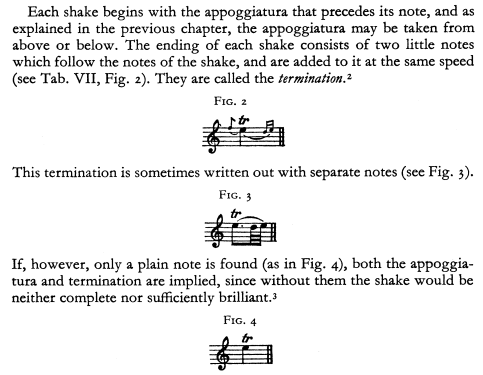
This is admirably clear. The starting appoggiatura may be long or short, but it and the termination are required, whether indicated or not.
Notice that Quantz allows the option of starting the trill with an appoggiatura from below (not the main note, but a step below). This type of start is under-utilized and rarely heard in performances today. It is described in many sources from the second half of the 18th century and thoughout the 19th century.
The instructions of Leopold Mozart, the father of W. A. Mozart, in his Violinschule of 1756 are the same as those in Quantz (English transaltion by Edith Knocker in "A Treatise on the Fundamental Principles of Violin Playing", Oxford, 1948): "The beginning and the end of a trill may be made in various ways. It can begin at once with the upper note downwards. ..... But it can also be prepared by a descending appoggiatura which is suspended rather longer, or by an ascending appoggiatura...."
He suggests that the lower-note start is good at cadences. A little later, he says "All short trills are played with a quick appoggiatura [from above] and a turn" and he gives this example:

There is no reason to suppose that Wolfgang Amadeus Mozart (1756–1791) ever deviated from the teachings of his father. There is no reason not to start every trill with the upper note in W. A. Mozart's flute quartets and flute concerti, in my opinion, and all sound better that way.
In his Versuch über die wahre Art das Clavier zu spielen of 1753 (English translation by W. J. Mitchell as "Essay on the True Art of Playing Keyboard Instruments", Eulenburg, 1974), C. P. E. Bach gives an encylopedic description of the types of trills (prefixes, suffixes, length) and the contexts where each type should or may be used. Both upper and lower-note starts are illustrated, but never a main-note start. Among a list of "other errors as ugly as they are frequent", he lists "plunging directly into a trill without playing a preceding appoggiatura...."
Among the instances of trills without suffix are the very short and rapid trills called Pralltrillers. In English sources, these are called half shakes, passing shakes, transient shakes, etc. C. P. E. Bach shows it with an upper-note start. On the right, below, is an example in context, with his fingering for the keyboard.


The Pralltriller works fine on a harpsichord, but he mentions that this ornament cannot be done well on the piano, even on the light fortepianos of his day, because the extreme quickness of the required snap tends to cause a piano player to play it too loudly. Flutists should remember that the Pralltriller in this form is quick but light.
Leopold Mozart, in the 1787 edition of his treatise, includes an illustration of the Pralltriller:

Daniel Gottlieb Türk's Klavier-Schule of 1789 is another very detailed and influential method. (English translation by R. H. Haggh: "School of Clavier Playing", U. of Nebraska, 1982.)

Türk goes on to criticize composers who indicate the upper note start with a small appoggiatura, saying it can only confuse the player as it is "basically quite superfluous". That is, according to Türk, it is not intended to indicate anything unusual, but was the normal thing to do.
For Türk, the Pralltriller still retains an upper-note start:

J. G. Tromlitz, in his ...Unterricht der Flöte zu Spielen of 1791, has a different take on some matters. From Ardal Powell's translation in "The Virtuoso Flutist", Cambridge, 1991: "The trill, when it appears in the course of a melody, is always dependent on an appoggiatura from above or below, or on a preceding note taking the place of an appoggiatura... But if the melody begins with a trill, it can take an appoggiatura, though a very short one... however, it can also be made without an appoggiatura."
So here is an exception—a main note start is OK, for Tromlitz in 1791, when the trill begins the melody.
Tromlitz thinks of the trill "proper" as starting with the main note, after the appoggiatura is finished, and that it is the main note that is to be accented, after the appoggiatura is finished. Not all sources agree with this.

This type of performance (a main-note start when the trill begins a phrase or is preceded by the upper or lower note, whether shown as slurred to it or not) may have been common at this time and even earlier.
Piano methods indicate a mixed practice in the 1790s; different teachers gave different explanations. Some recommend main-note starts for trills; others don't. We remark that some "musical clocks" (mechanical musical instruments) from this period show a predominance of main-note-start trills. For some details, see Sandra Rosenblum's Performance Practices in Classical Piano Music (Indiana U. Press, 1988). It is likely that pianists were among the first to use main-note starts indiscriminately, in part because of the reasons Hummel gives (see below).
Mathieu Peraut's Méthode pour la Flûte (Paris, c.1800) is very careful to show all trills starting on the upper note, with the exception of a single cadential trill starting on the note a step below the main note (second illustration).
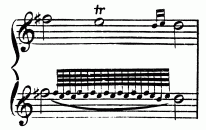
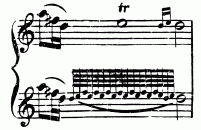
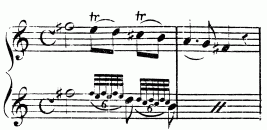
Muzio Clementi's Introduction to the Art of Playing on the Pianoforte of 1801 contains an ornament table from which the following is drawn:
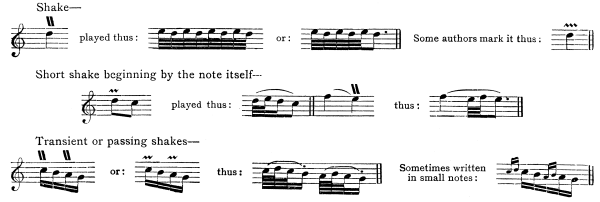
Clementi distinguishes short trills and passing shakes, but shows both with main-note starts. The meaning of passing shake (Pralltriller) has changed, and it will be shown this way (three notes, main-upper-main) and in this context (on the first of a pair of scale-wise descending notes) in almost all methods after 1800. It is often shown with a triplet rhythm (see under Dressler below). C. P. E. Bach and others would have called this so-called Pralltriller a Schneller rather than a proper Pralltriller, and many today would call it an inverted mordent.
A complete trill in Clementi starts with the upper or lower note, and not the main note. A sometime exception is when the note on which the trill is to be made is preceded by a note below or above it; see the last line below (also cf. the illustration from Tromlitz, above).
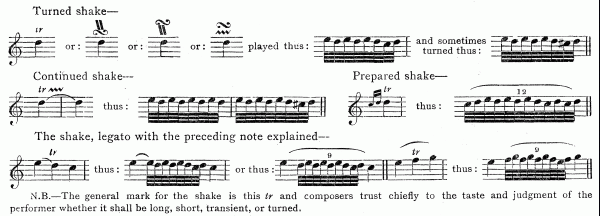
Tebaldo Monzani's Instructions for Playing the German-Flute [PDF version here] was first published in 1801. The excerpts we give below are from the 3rd Edition, c.1813. Concerning the performance of trills, he shows only what we see immediately below in his brief table of ornaments.

But in a companion volume, Seven Studios [PDF version here], to his Instructions, we find the following in Studio 1 (marked allegro moderato). Monzani is presumably cautioning against a three-note Pralltriller as shown in Clementi. (This may also indicate that it is acceptable or encouraged to add short trills in similar passages where Monzani has written only short appoggiaturas. The short appoggiaturas are, of course, always firmly on the beat—see here.)

In Hugot and Wunderlich's "Méthode de Flûte" of 1804, trills are introduced as starting on the upper note. This is still the standard. But they explain that trills can start with either the main note, the upper note, or the lower note, and they indicate two instances where they say either an upper-note start or main-note start may be used.

(The articulation is curiously changed when they illustrate the main-note start in the second instance.)

From J. B. Cramer's Instructions for the Pianoforte (c.1810): "The Shake begins with the note above and ends on the principal note; when at the end of a piece it is generally followed by a turn...". All shakes illustrated in Fancesco Pollini's Methodo del clavicembelo (c.1811) begin with the upper accessory, according to E. Dannreuter's Musical Ornamentation.
The explanation of trills in Rafael Dressler's New and Complete Instructions for the Flute (1827) [available here; see page 27] is very brief. The trill is described with examples starting on the main note, and this is presumably his preference. But after it is clear what a trill is, he says "It may be commenced in different ways; with the principal note itself, with the note above, or with a turn written in small notes." Passing shakes (Pralltrillers) start with the main note.

A. B. Fürstenau's explanation of trills in his Flöten-Schule, Op.42, of 1826 is essentially the same as Dressler's. So is the description of trills by E. Walckiers in his Méthode de Flûte, Op. 30, of 1829.
But Drouët's Method of Flute Playing (London, 1830) is somewhat different. Drouët shows the trill first as an alteration of quarter notes starting with the main note. But that is just to fix the idea of alternating adjacent notes. His following examples make clear that he strongly prefers the upper-note start, and in case it is not clear, he states "It is necessary to remark that the shake commences with the note above." He shows very short trills as a triplet, as in Dressler.

Thomas Lindsay, in his The Elements of Flute-Playing, Part II (1830) says "Theorists are not agreed whether the Shake should begin with the [main] or upper note; it is, consequently, as often performed one way as the other."

Lindsay starts many trills with the main note:
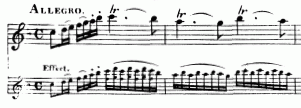
In the case of the chain of trills shown below, Lindsay says either an upper or main-note start is OK—with the best effect obtained, assuming time permits, with an upper-note start and a turn on each trill.
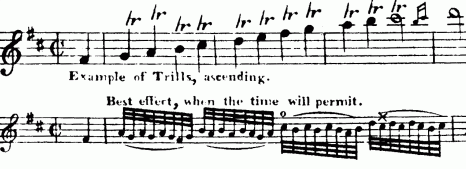
A strong recommendation of a rule that all trills begin with the main note was advanced by J. N. Hummel in 1828, the year after Beethoven's death. In his Ausführliche Theoretisch Practische Anweisung zum Pianofortespiel, he states that he wishes to break with previous practice and henceforth start all trills with the main-note, in part simply because that's often easier on the piano. Here are his words (translation from Edward Dannreuter's Musical Ornamentation of 1894):
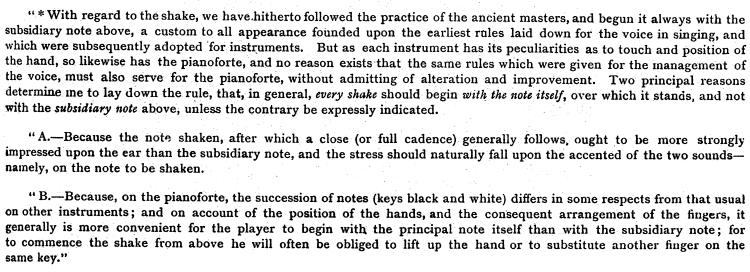
L. Spohr in his Violinschule of 1832 says "Every shake generally begins ... with the principle note ...". A footnote states "This rule J. N. Hummel first advanced in his Piano-forte School...". A. B. Fürstenau, in his Die Kunst des Flötenspiels, Op.138, of 1844 agrees with the main-note-start rule and acknowledges the treatises of Hummel and Spohr (and Kalkbrenner, 1831) by name. His 1844 method omits the list of alternative starts that his 1826 Flöten-schule gave.
Still, flutists need not follow Hummel's rule for all music of the mid and late 19th century. For example, Rudolf Tillmetz included trills in his Melodic Etudes, Op.47, of c.1900 for which he used written short appoggiaturas to indicate an upper-note start (e.g., twice in Etude 1).
